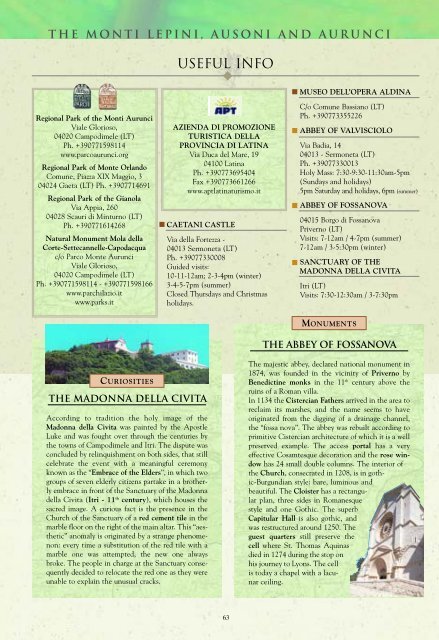Walking through time Walking through time - IBAM
Walking through time Walking through time - IBAM
Walking through time Walking through time - IBAM
Create successful ePaper yourself
Turn your PDF publications into a flip-book with our unique Google optimized e-Paper software.
the MONTI lepini, AUSONI and AURUNCI<br />
Useful info<br />
MUSEO DELL’OPERA ALDINA<br />
Regional Park of the Monti Aurunci<br />
Viale Glorioso,<br />
04020 Campodimele (LT)<br />
Ph. +390771598114<br />
www.parcoaurunci.org<br />
Regional Park of Monte Orlando<br />
Comune, Piazza XIX Maggio, 3<br />
04024 Gaeta (LT) Ph. +3907714691<br />
Regional Park of the Gianola<br />
Via Appia, 260<br />
04028 Scauri di Minturno (LT)<br />
Ph. +390771614268<br />
Natural Monument Mola della<br />
Corte-Settecannelle-Capodacqua<br />
c/o Parco Monte Aurunci<br />
Viale Glorioso,<br />
04020 Campodimele (LT)<br />
Ph. +390771598114 - +390771598166<br />
www.parchilazio.it<br />
www.parks.it<br />
AZIENDA DI PROMOZIONE<br />
TURISTICA DELLA<br />
PROVINCIA DI LATINA<br />
Via Duca del Mare, 19<br />
04100 Latina<br />
Ph. +390773695404<br />
Fax +390773661266<br />
www.aptlatinaturismo.it<br />
CAETANI CASTLE<br />
Via della Fortezza -<br />
04013 Sermoneta (LT)<br />
Ph. +39077330008<br />
Guided visits:<br />
10-11-12am; 2-3-4pm (winter)<br />
3-4-5-7pm (summer)<br />
Closed Thursdays and Christmas<br />
holidays.<br />
C/o Comune Bassiano (LT)<br />
Ph. +390773355226<br />
ABBEY OF VALVISCIOLO<br />
Via Badia, 14<br />
04013 - Sermoneta (LT)<br />
Ph. +39077330013<br />
Holy Mass: 7:30-9:30-11:30am-5pm<br />
(Sundays and holidays)<br />
5pm Saturday and holidays, 6pm (summer)<br />
ABBEY OF FOSSANOVA<br />
04015 Borgo di Fossanova<br />
Priverno (LT)<br />
Visits: 7-12am / 4-7pm (summer)<br />
7-12am / 3-5:30pm (winter)<br />
SANCTUARY OF THE<br />
MADONNA DELLA CIVITA<br />
Itri (LT)<br />
Visits: 7:30-12:30am / 3-7:30pm<br />
MONUMENTS<br />
the abbey of Fossanova<br />
CURIOSITIES<br />
the madonna della Civita<br />
According to tradition the holy image of the<br />
Madonna della Civita was painted by the Apostle<br />
Luke and was fought over <strong>through</strong> the centuries by<br />
the towns of Campodimele and Itri. The dispute was<br />
concluded by relinquishment on both sides, that still<br />
celebrate the event with a meaningful ceremony<br />
known as the “Embrace of the Elders”, in which two<br />
groups of seven elderly citizens partake in a brotherly<br />
embrace in front of the Sanctuary of the Madonna<br />
della Civita (Itri - 11 th century), which houses the<br />
sacred image. A curious fact is the presence in the<br />
Church of the Sanctuary of a red cement tile in the<br />
marble floor on the right of the main altar. This “aesthetic”<br />
anomaly is originated by a strange phenomenon:<br />
every <strong>time</strong> a substitution of the red tile with a<br />
marble one was attempted, the new one always<br />
broke. The people in charge at the Sanctuary consequently<br />
decided to relocate the red one as they were<br />
unable to explain the unusual cracks.<br />
The majestic abbey, declared national monument in<br />
1874, was founded in the vicinity of Priverno by<br />
Benedictine monks in the 11 th century above the<br />
ruins of a Roman villa.<br />
In 1134 the Cistercian Fathers arrived in the area to<br />
reclaim its marshes, and the name seems to have<br />
originated from the digging of a drainage channel,<br />
the “fossa nova”. The abbey was rebuilt according to<br />
primitive Cistercian architecture of which it is a well<br />
preserved example. The access portal has a very<br />
effective Cosamtesque decoration and the rose window<br />
has 24 small double columns. The interior of<br />
the Church, consecrated in 1208, is in gothic-Burgundian<br />
style: bare, luminous and<br />
beautiful. The Cloister has a rectangular<br />
plan, three sides in Romanesque<br />
style and one Gothic. The superb<br />
Capitular Hall is also gothic, and<br />
was restructured around 1250. The<br />
guest quarters still preserve the<br />
cell where St. Thomas Aquinas<br />
died in 1274 during the stop on<br />
his journey to Lyons. The cell<br />
is today a chapel with a lacunar<br />
ceiling.<br />
63
















